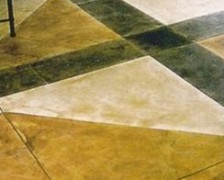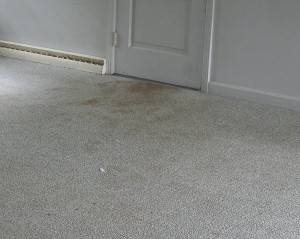Posted by Teresa on August 24, 2010 under Landlord Tips | 
 When it comes to refunding security deposits, most landlords and tenants will squabble at some point over the flooring in the rental unit. Carpets get stained or wear out, hardwood is easily scratched, and vinyl flooring doesn’t always hold up to tenant wear-and-tear.
When it comes to refunding security deposits, most landlords and tenants will squabble at some point over the flooring in the rental unit. Carpets get stained or wear out, hardwood is easily scratched, and vinyl flooring doesn’t always hold up to tenant wear-and-tear.
What is the best flooring choice for rental units? And how do you decide whether it’s time to switch to something new in your investment properties?
Ask a dozen landlords those two questions, and you’ll likely get a dozen answers. One thing most agree on is that carpet, while it can be the most economical choice, will often give you the most headaches.
Why? Carpet stains and odors are notoriously difficult to remove. A tenant’s pet, cigarette smoke and food odors are absorbed into carpets and padding and can permeate the air in the rental unit—as well as the sub-flooring below. However, in higher-end rentals, tenants may expect nice carpeting—just make sure your security deposit covers damage repair. Landlords know ruined carpeting can occur at every rent point.
- Individual adhesive-backed vinyl tiles are the first choice of many landlords—for bathrooms, kitchens or even the entire unit. They are inexpensive, easy to install and easy to replace. Some landlords we’ve talked to prefer commercial-grade tiles over the less-costly home variety because they hold up better.
- Tenants love hardwood floors. They look fantastic and add value to your rental unit, so if you have hardwood floors, make sure you advertise that fact! But what about caring for them? For homes that are lived in for years, it’s not as large an issue as it is for rental units that might have furniture moved in, out and around every 12 months. Some floor refinishers will recommend a harder topcoat if you inform them it’s a rental unit. Still, tenants can find ways to scratch and gouge the floors. Ask tenants to use floor protectors on furniture legs.
Furniture moving hint: When sliding furniture across a floor, put a thick sock on each leg to make it easier—and save the floor.
- Consider painting the hardwood floor instead. Floor paint is tough and easy to apply yourself. It’s less expensive than refinishing the floors, and between tenants you can repaint it quickly. Make sure you allow it time to cure completely before allowing the new tenant to move furniture in.
- Finally, landlords are starting to use concrete floors more often. They are inexpensive and easy to maintain. In addition, concrete is extremely durable and can be stained or colored to look very attractive. The key to a great looking concrete floor is proper polishing. Keep in mind that concrete floors tend to be hard and cold. Some landlords limit their use to kitchens and bathrooms.
Every landlord must balance initial cost, maintenance requirements and lifespan of flooring options before deciding which way to go. What issues have you encountered when replacing flooring in rental units?
Pre-screen all tenants as part of your standard application process. Background and credit checks will help ensure you rent to qualified tenants. For more landlord resources, including forms and information on tenant screening, turn to E-Renter.com.
Posted by Teresa on August 10, 2009 under Landlord and Tenant FAQs, Landlord Tenant Lawsuits, Landlord Tips | 
 Landlord vs. tenant issues seem to occur in the same general areas. One item that landlords and tenants frequently clash over is flooring. Whether your rental unit floors are covered with carpeting, hardwood, or tile, you and your tenants will likely have issues with them at some point. We’ve put together some guidelines to help deal with damages or requests for replacement.
Landlord vs. tenant issues seem to occur in the same general areas. One item that landlords and tenants frequently clash over is flooring. Whether your rental unit floors are covered with carpeting, hardwood, or tile, you and your tenants will likely have issues with them at some point. We’ve put together some guidelines to help deal with damages or requests for replacement.
Determine the extent of the damage. Are you seeing normal wear and tear, minor damages, or major damages?
Normal means high-traffic areas are starting to show wear.
Minor damages include:
- Carpet indentations
- Minor scratches in wood floors
- Color fading
Major damages include:
- Stains
- Burns
- Carpet wrinkling
- Deep scratches in wood
- Gouges in laminate
- Chipped or broken tiles
- Carpet odors
Determine the cause of the damage. Keep in mind that some of the above issues may be a result of the quality of floor covering or the installation method—and may not be your tenants’ fault. Improper tile installation can lead to cracks. Poor quality carpet will wear quickly. Obviously, pet stains and odors, burns, or food stains that were not present at move-in are the responsibility of your tenant.
Can the damage be repaired? Most flooring can be, so you might be able to avoid the cost of replacement. Contact a local flooring contractor or installer to provide an estimate for repair. You can require your tenant to take care of the bill if they are at fault.
How old is the flooring? Carpet and laminate will wear out. If you have 20-year-old carpet in a rental unit, then obviously, it should be replaced. And, low-quality, inexpensive carpet won’t last even five years under heavy use. The more people and animals walking on it, the quicker it will wear out! You’ll attract a higher-quality tenant with newer flooring.
So what’s the best flooring to avoid landlord and tenant issues? Unfortunately, there is no “best” flooring choice when it comes to rental units. Many landlords we hear from prefer hardwood, such as oak. It’s tough and lasts for hundreds of years with proper care. In older homes, hardwood can be painted to reduce upkeep and hide signs of wear.
If you want to install carpet, use your best judgment. Keep price and quality in line with the level of rent you are charging. Spell out your tenants’ responsibilities when it comes to caring for the floors, and thoroughly document the floor’s condition at move in and again at move out. That way, if damages occurred during the tenant’s stay, you have proof enough to deduct the amount from the security deposit—or to charge them more to cover the difference.
For more landlord resources, including forms and information on
tenant screening, turn to
E-Renter.com. You’ll know that you have the best possible tenants when you
prescreen tenants.
 When it comes to refunding security deposits, most landlords and tenants will squabble at some point over the flooring in the rental unit. Carpets get stained or wear out, hardwood is easily scratched, and vinyl flooring doesn’t always hold up to tenant wear-and-tear.
When it comes to refunding security deposits, most landlords and tenants will squabble at some point over the flooring in the rental unit. Carpets get stained or wear out, hardwood is easily scratched, and vinyl flooring doesn’t always hold up to tenant wear-and-tear.
